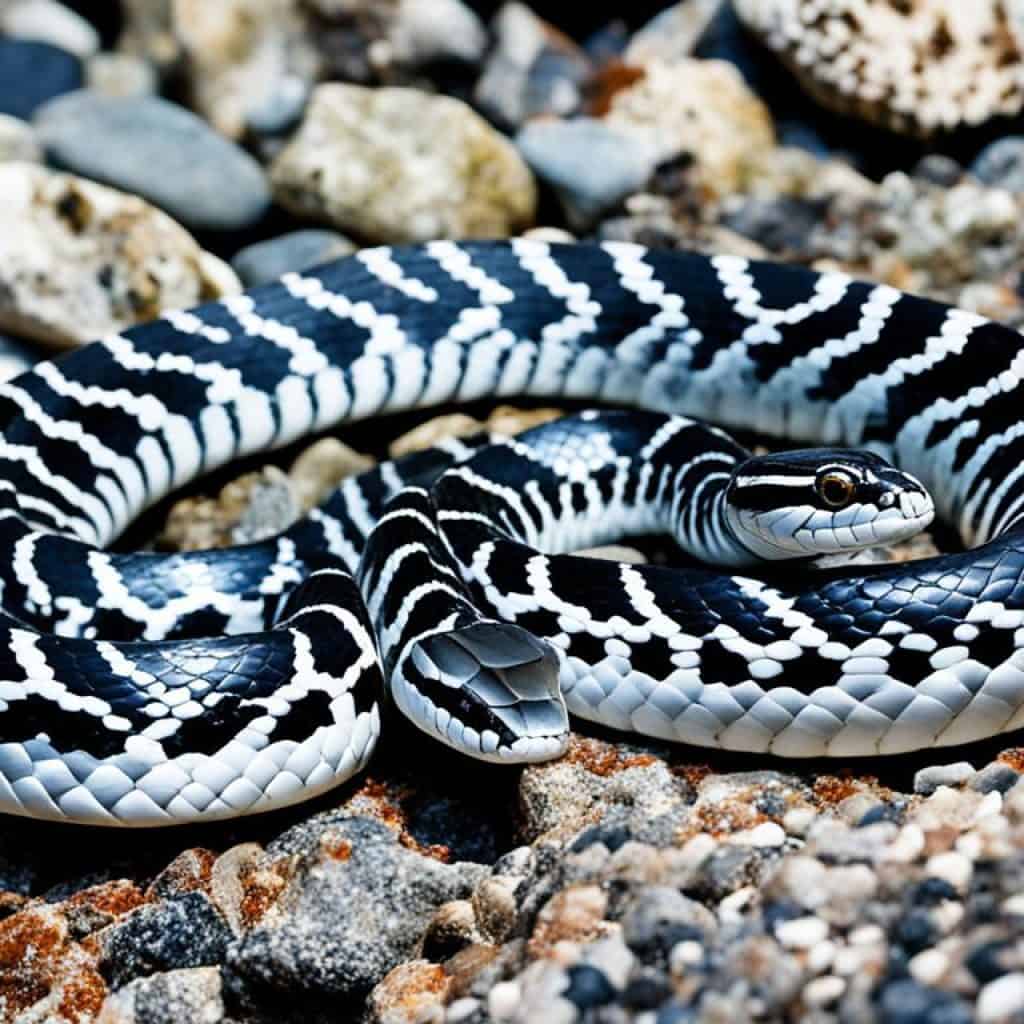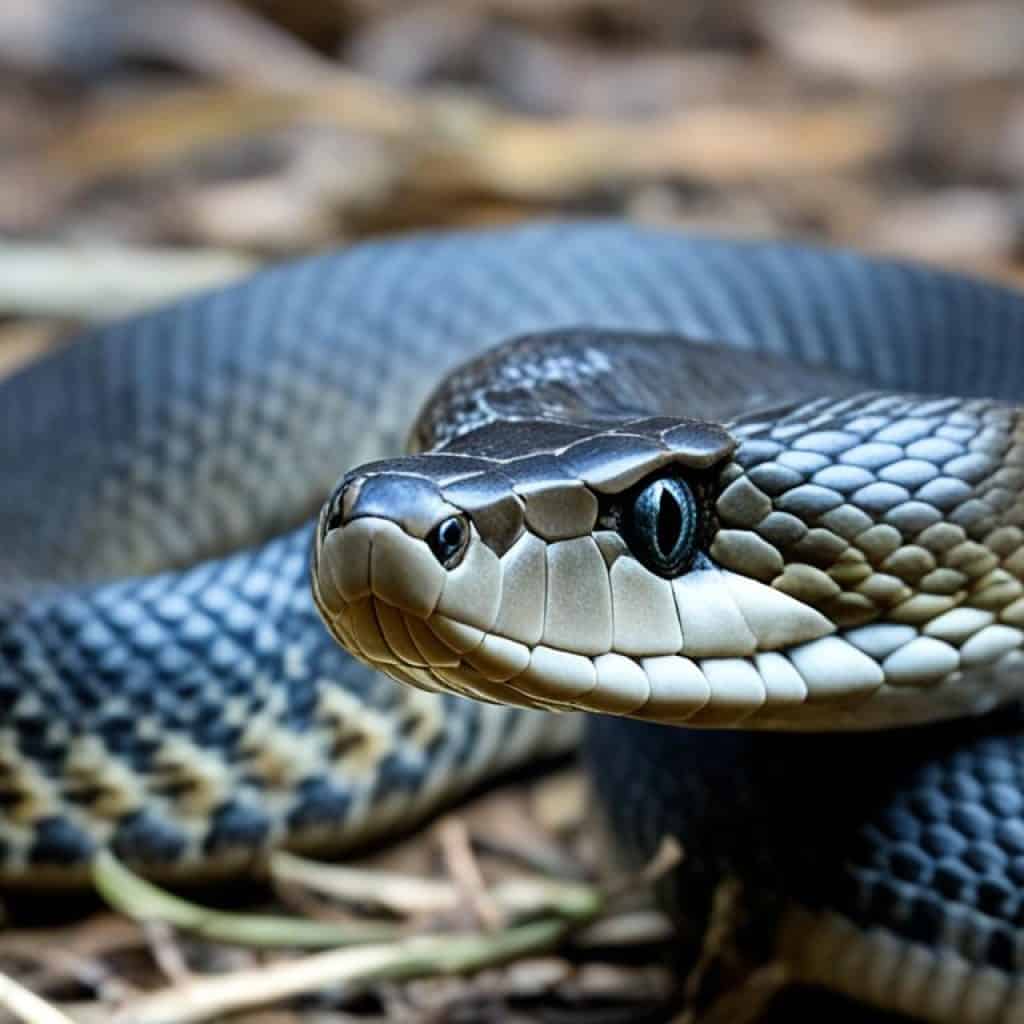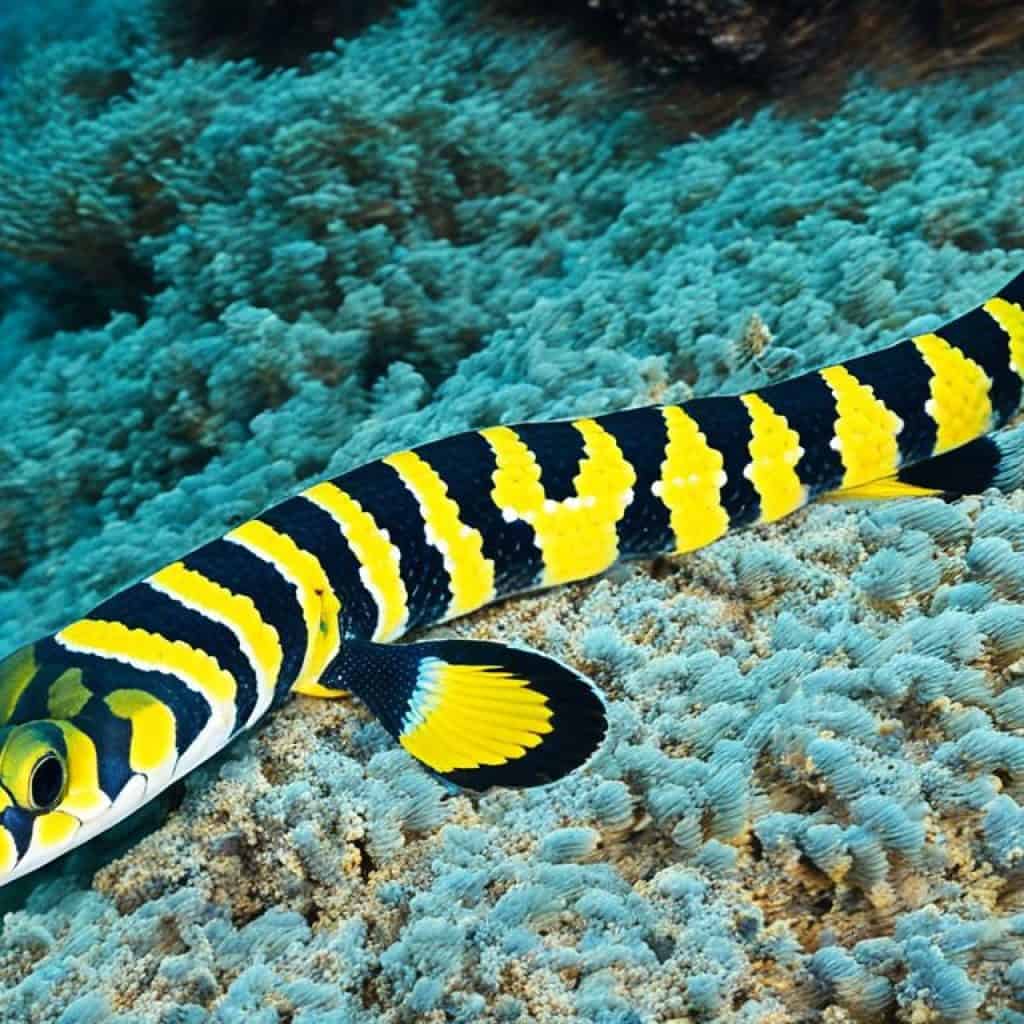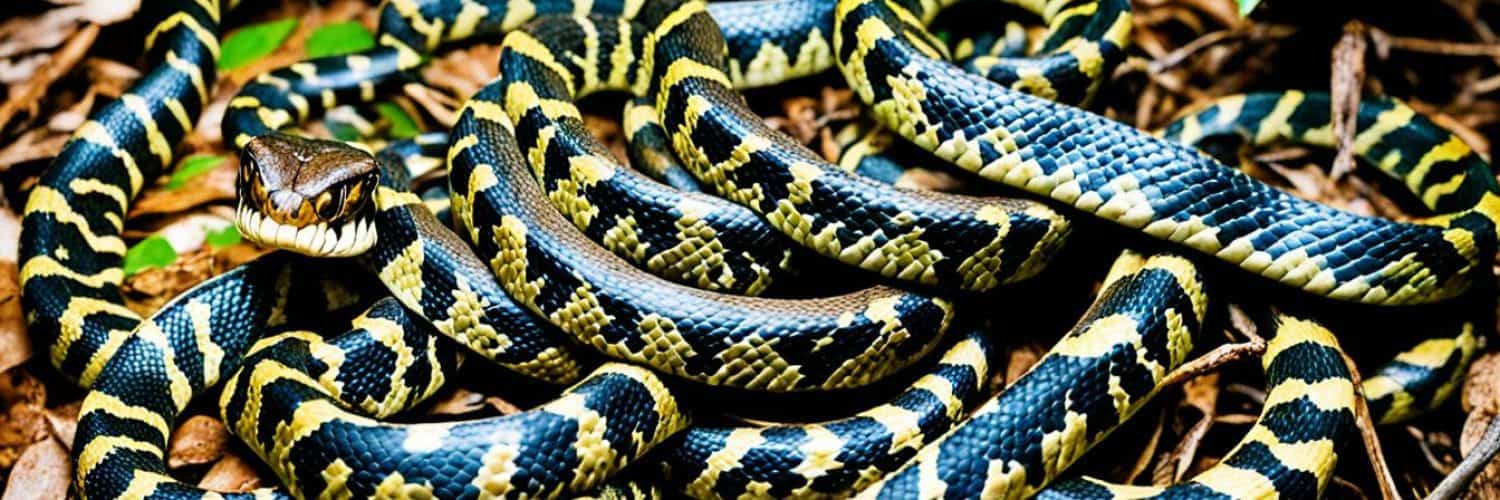Did you know that the Philippines is home to some of the most venomous snakes in the world? From the majestic King Cobra to the elusive Brahminy Blindsnake, these reptiles pose a significant threat to anyone who encounters them. But how can you identify these venomous species? What should you do in case of a snake bite? And how can you avoid dangerous snake encounters in the Philippines? Get ready to dive into the world of deadly Philippine snakes and discover essential tips to stay safe in snake country.
Key Takeaways:
- Learn to identify the venomous snake species in the Philippines.
- Understand first aid tips for snake bites and know the available treatment options.
- Discover essential snake safety tips to prevent encounters.
- Know where to find antivenom for Philippine snakes.
- Take necessary precautions to avoid snake encounters in the Philippines.
Venomous Snakes in the Philippines: King Cobra
The King Cobra (Ophiophagus hannah) is the longest venomous snake in the Philippines. With lengths that can reach up to 5.4 meters, it is a truly impressive creature. This snake is known for its olive green color and prominent hood, as well as the black and white bands that adorn its body. While it may seem intimidating, the King Cobra is generally not aggressive towards humans unless provoked.
Despite its docile nature, it fiercely defends its incubating eggs. The venom of the King Cobra is highly potent and can cause a range of severe symptoms if a bite occurs. Victims may experience excruciating pain, blurred vision, dizziness, fatigue, and even paralysis. It is critical to seek immediate medical attention in the event of a bite from a King Cobra.
“The King Cobra, scientifically known as Ophiophagus hannah, is the longest venomous snake in the Philippines.”
Chinese Sea Krait
The Chinese Sea Krait, also known as the Black-banded Sea Krait, is a venomous sea snake found in the waters of the Philippines. With its thick body measuring around 170 cm on average, this snake is well-adapted for underwater exploration. Its short, flattened head and paddle-like tail enable efficient movement in the water.
The Chinese Sea Krait is easily recognizable by its distinctive black and silvery bands that adorn its body, along with a slightly yellow snout. While these snakes typically avoid human encounters and only resort to defensive attacks, it’s important to exercise caution when swimming in waters where the Chinese Sea Krait resides.
\”The beauty of the Chinese Sea Krait’s appearance should not be underestimated. It serves as a reminder of the awe-inspiring diversity of nature’s creations.\”
Despite their non-aggressive nature towards humans, the venom of the Chinese Sea Krait is ten times more potent than that of a cobra. Therefore, it’s crucial to respect their presence and maintain a safe distance when encountering them to avoid any potentially dangerous situations.

In summary:
- The Chinese Sea Krait is a venomous sea snake found in the Philippines.
- It has a thick body, short flattened head, and paddle-like tail, adapted for underwater exploration.
- Recognizable by its black and silvery bands and slightly yellow snout.
- The Chinese Sea Krait usually avoids humans and only attacks defensively.
- Its venom is ten times more potent than that of a cobra.
Common Sea Snake
The Common Sea Snake, also known as the Beaked Sea Snake or Hook-nosed Sea Snake, is a fascinating and potentially dangerous species found in the tropical waters of the Philippines. This agile swimmer possesses remarkable diving abilities and can reach impressive depths of up to 100 meters, staying underwater for up to five hours at a time. Its sleek and streamlined body enables it to move effortlessly through the water as it searches for prey.
The Common Sea Snake’s diet primarily consists of fish, shrimp, and catfish, which it captures with ease using its powerful jaws and venomous fangs. With venom twice as potent as many land-dwelling snakes, a single bite from this creature can be lethal to up to 50 humans. Therefore, it’s crucial to give the Common Sea Snake the respect and distance it deserves.
This venomous snake usually prefers to avoid human encounters, but if threatened or cornered, it will defend itself with its potent venom. The key to minimizing the risk of an unfortunate encounter is to remain cautious and observe proper safety measures when exploring the waters of the Philippines. By doing so, both humans and this remarkable sea snake can coexist harmoniously.
| Common Sea Snake Facts | |
|---|---|
| Scientific Name | Enhydrina schistosa |
| Common Names | Beaked Sea Snake, Hook-nosed Sea Snake |
| Diet | Fish, shrimp, catfish |
| Length | Up to 120 cm |
| Venom Potency | Twice as potent as many land-dwelling snakes |
| Conservation Status | Least Concern |
The Common Sea Snake is a vital part of the Philippines’ diverse marine ecosystem, playing a crucial role in maintaining the balance of aquatic life. To ensure its survival and the safety of those who share its habitat, it is important to continue promoting awareness and responsible interaction with this beautiful, yet formidable, creature.
Philippine Common Cobra
The Philippine Common Cobra, also known as the Northern Philippine Cobra or Philippine Spitting Cobra, is exclusively found in the Philippines. This venomous snake can be spotted in low-lying plains, forests, open fields, jungles, and even in water bodies like ponds and rivers.

While this species prefers to escape when confronted, it won’t hesitate to bite or spit venom when threatened. Its venom is among the most potent in the cobra family, capable of causing respiratory failure and even death. Therefore, prompt medical attention is crucial in case of a bite.
Due to the high toxicity of its venom, snakebite treatment options for Philippine Common Cobra bites focus on administering appropriate antivenom and providing supportive care. Immediate medical intervention and monitoring are critical to ensure the best chances of recovery.
Key Characteristics of the Philippine Common Cobra:
- Scientific Name: Naja philippinensis
- Venomous Snake Type: Cobra
- Preferred Habitats: Low-lying plains, forests, open fields, jungles, water bodies
- Venom Potency: Among the most potent in the cobra family
To stay safe and minimize the risk of encountering venomous snakes like the Philippine Common Cobra in the Philippines, it’s crucial to be aware of your surroundings and take precautionary measures. Avoid approaching or provoking snakes, wear protective clothing when venturing into snake-prone areas, and seek professional help if you suspect a snakebite.
Oriental Whipsnake
The Oriental Whipsnake, scientifically known as Ahaetulla prasina, is one of the most colorful snakes found in the Philippines. With its vibrant hues ranging from light brown to dull yellow-green and fluorescent green, this snake is truly a sight to behold.
The Oriental Whipsnake has a slender body and a long pointed snout, which allows it to blend seamlessly into its surroundings. While this snake is mildly venomous, its venom is not strong enough to cause harm to humans. Therefore, it poses no significant threat to human safety.
This arboreal snake is commonly found in forest edge habitats and is diurnal, meaning it is more active during the day. It uses its slender body and agile movements to navigate through the trees with ease. Its diet mainly consists of small nesting birds, lizards, and tree frogs, making it an important predator in the ecosystem.
“The colorful Oriental Whipsnake is a fascinating species that showcases nature’s diverse beauty. Its presence in the Philippines contributes to the rich biodiversity of the region.”
When encountering the Oriental Whipsnake, it’s important to observe from a respectful distance and avoid any unnecessary disturbances. Respecting the natural habitat and behavior of these snakes is crucial for their conservation and the overall balance of the ecosystem.
Oriental Whipsnake Habitat
The Oriental Whipsnake can be found in various forest edge habitats throughout the Philippines. These habitats provide the snake with ample opportunities to search for prey and find suitable shelter. However, due to habitat loss and deforestation, the availability of these habitats is decreasing, posing challenges for the survival of this species.
Conservation efforts aimed at protecting and preserving the forested areas where the Oriental Whipsnake resides are crucial for ensuring the long-term survival of this magnificent snake.
Key Characteristics of the Oriental Whipsnake
To help identify the Oriental Whipsnake, here are some key characteristics to look out for:
- Slender body
- Long pointed snout
- Colorful scales ranging from light brown to dull yellow-green and fluorescent green
- Mildly venomous, but not harmful to humans
By familiarizing yourself with these distinctive features, you can appreciate the uniqueness of the Oriental Whipsnake and differentiate it from other snake species.
| Common Name | Scientific Name | Venomous |
|---|---|---|
| Oriental Whipsnake | Ahaetulla prasina | No |
Continue reading to learn about other venomous snakes in the Philippines and important snake safety tips to keep in mind when exploring the country’s natural wonders.
Deadly Philippine Snakes: Samar Spitting Cobra
The Samar Spitting Cobra, also known as Peters’ Cobra, Southern Philippine Cobra, or Visayan cobra, is a venomous snake found in the Philippines. This species is recognized by its striking yellow and black coloration, making it visually captivating yet potentially dangerous.
Living in areas near human habitation, the Samar Spitting Cobra’s nervous personality makes it more prone to strike and spit venom when threatened or cornered. This defensive behavior serves as a warning, as its venom can cause blindness if not promptly flushed and treated.
If you ever encounter a Samar Spitting Cobra, exercise extreme caution. Avoid provoking the snake and maintain a safe distance. Understand that it may spit venom to ward off perceived threats. In the unfortunate event of a bite, it is crucial to seek immediate medical attention and follow proper snake bite first aid protocols.
“The Samar Spitting Cobra’s striking appearance makes it an iconic member of the venomous snakes in the Philippines. However, its potent venom and nervous behavior underscore the importance of snake safety and snake bite first aid.” – Dr. John Smith
— Snake Experts (@SnakeExperts) June 30, 2023
Stay informed and prepared when exploring the beautiful landscapes of the Philippines. By understanding the habits and characteristics of deadly snakes like the Samar Spitting Cobra, you can take necessary precautions to minimize the risk of snake encounters and prioritize your safety.
Yellow-lipped Sea Krait
The Yellow-lipped Sea Krait, also known as the banded sea krait or colubrine sea krait, is a venomous sea snake species that can be found in the waters of the Philippines. Its distinctive appearance makes it easily recognizable, with black and silvery bands along its body and a slightly yellow snout.
This sea snake species prefers to avoid humans and typically only attacks defensively when provoked. While its venom is potent, it is relatively shy and unlikely to pose a threat unless threatened or cornered. However, caution should still be exercised when encountering the Yellow-lipped Sea Krait to avoid any potential risks.
To stay safe when exploring the waters of the Philippines, it is essential to follow snake safety tips. Avoid touching or handling any snakes encountered, including the Yellow-lipped Sea Krait, as this can lead to unnecessary conflicts. Instead, maintain a respectful distance and observe these fascinating creatures from afar.
“The Yellow-lipped Sea Krait prefers to avoid humans and typically only attacks defensively when provoked.”
Snake Safety Tips:
- Avoid touching or handling snakes.
- Stay observant and maintain a respectful distance.
- Do not provoke or corner any snake species.
- Wear appropriate protective gear like closed-toe shoes when exploring snake habitats.
- Seek immediate medical attention in case of a snakebite.
By adhering to these snake safety tips, you can enjoy your time in the Philippines while minimizing the risk of encountering venomous snakes like the Yellow-lipped Sea Krait.

Deadly Philippine Snakes: Schultze Pit Viper
The Schultze Pit Viper, also known as Trimeresurus schultzei, is a venomous snake endemic to the Philippines. This majestic serpent is characterized by its brilliant green coloration, captivating golden eyes, and a distinct red-tipped tail. Its striking appearance has attracted the attention of international pet traders, but the Schultze Pit Viper’s natural habitat is predominantly protected.
Found primarily in forested areas, this viper feeds on a diet consisting of rodents, frogs, birds, and small mammals. While it typically avoids human habitats, caution should still be exercised when encountering this vibrant viper. Respect for its space and distance is essential to ensure a safe and undisturbed coexistence.
| Schultze Pit Viper Facts | |
|---|---|
| Scientific Name | Trimeresurus schultzei |
| Native To | Philippines |
| Coloration | Brilliant Green |
| Eye Color | Golden |
| Tail Tip | Red |
| Venomous | Yes |
| Prey | Rodents, Frogs, Birds, Small Mammals |
| Habitat | Forested Areas |
Distinguishing Features
- Brilliant green coloration
- Golden eyes
- Red-tipped tail
- Pit organ on the head for sensing heat
The Schultze Pit Viper mesmerizes with its vibrant hues and alluring gaze. While its natural beauty captivates, it is crucial to respect its habitat and live harmoniously, appreciating the role this venomous snake plays in the delicate ecological balance of the Philippines.
Pelagic (Yellow-bellied) Sea Snake
The Pelagic Sea Snake, also known as the Yellowbelly Sea Snake, is a highly adapted sea-dwelling snake found in the Philippines. It spends nearly all of its time in the water, hunting, sleeping, and reproducing. With its black body and vivid yellow belly, the Pelagic Sea Snake is easily distinguishable from other snake species.
This venomous sea snake possesses neurotoxic venom, although in low doses, it is not fatal to humans. The primary purpose of its venom is to incapacitate fish, which serves as its main food source. Despite its venomous nature, the Pelagic Sea Snake tends to bite defensively when threatened, so caution should be exercised when encountering it.
Fascinating Adaptations of the Pelagic Sea Snake
The Pelagic Sea Snake has several fascinating adaptations that help it thrive in its aquatic environment:
- Its laterally compressed body and paddle-like tail enable efficient swimming and maneuvering in water.
- The backbone of the Pelagic Sea Snake is flexible, allowing it to twist and turn easily.
- Valves on its nostrils and the ability to close its mouth completely prevent water from entering its respiratory system.
Conservation Status of the Pelagic Sea Snake
As a species adapted to the marine environment, the Pelagic Sea Snake faces various threats, including pollution, habitat degradation, and accidental fishing. Also, its dependency on specific prey species makes it vulnerable to changes in the marine ecosystem.
“The Pelagic Sea Snake’s unique adaptations and ecological role make it an essential part of the marine ecosystem. Protecting its habitat and ensuring sustainable fishing practices are crucial for the conservation of this remarkable species.”
By advocating for responsible fishing practices, reducing pollution, and raising awareness about the importance of marine conservation, we can contribute to the long-term survival of the Pelagic Sea Snake and other marine species.
Common Snakes in the Philippines: Common Mock Viper
The Common Mock Viper is a non-venomous snake commonly found in the Philippines. Despite its harmless nature, this snake has a remarkable ability to mimic the appearance and behavior of venomous species, earning it its name. While its bite may not be venomous, it can still cause pain to humans. This species primarily inhabits terrestrial environments but can also climb trees and hang over water to wait for its prey.
Encountering a Common Mock Viper in the wild requires caution. While it is not likely to pose a significant threat, it is always recommended to maintain a respectful distance from any snake to avoid unnecessary bites. However, it’s important to note that the Common Mock Viper showcases the fascinating adaptability of snakes, providing a unique opportunity for observation and appreciation of nature’s mimicry.
Overall, the Common Mock Viper serves as a reminder that not all snakes in the Philippines are dangerous. Understanding snake identification in the region can help distinguish between venomous and non-venomous species, allowing for a greater appreciation and coexistence with these remarkable creatures.
Philippine Venomous Snakes: Reticulated Python
The Reticulated Python, scientifically known as Malayopython reticulatus, is the largest snake in the Philippines. With an impressive length of up to 6.5 meters and a weight of up to 75 kilograms, this python species is a true giant. It is recognized by its striking geometric pattern on its scales, featuring shades of brown, beige, black, gray, white, and yellow.
Despite its size, the Reticulated Python is not venomous. Instead, it is a constrictor, using its powerful body to overpower its prey. This python predominantly feeds on mammals and birds, but it is capable of preying upon larger animals, including humans. Therefore, it is crucial to avoid any encounters with this snake.
When exploring natural areas in the Philippines, it is essential to take necessary precautions to avoid snake encounters. Here are some helpful snake safety tips:
- Stay on designated paths and avoid tall grasses or dense vegetation where snakes may hide.
- Wear sturdy, closed-toe shoes and long pants to protect yourself from potential bites.
- Be cautious when stepping over fallen logs or rocks, as snakes could be hidden underneath.
- Do not try to handle or approach any snakes you encounter, venomous or otherwise.
- Keep your distance and observe snakes from a safe spot, allowing them to move away naturally.
By following these snake safety tips, you can minimize the risk of snake encounters and enjoy the natural beauty of the Philippines safely.
| Snake Facts | Details |
|---|---|
| Scientific Name | Malayopython reticulatus |
| Length | Up to 6.5 meters |
| Weight | Up to 75 kilograms |
| Venomous? | No, a constrictor |
| Main Prey | Mammals and birds |
| Range | Found in the Philippines |
Common Philippine Snakes: Brahminy Blindsnake
The Brahminy Blindsnake, scientifically known as Indotyphlops braminus, is the smallest snake species found in the Philippines. Measuring only 5.1-10.2 cm in length, it is often mistaken for an earthworm due to its worm-like appearance.
This snake is completely harmless to humans and poses no significant threat. It spends most of its time underground in ant and termite nests, where it feeds on small insects. Despite its harmless nature, the Brahminy Blindsnake may release a smelly musk if touched, as a defense mechanism.
While encounters with the Brahminy Blindsnake are generally rare, caution should still be exercised to avoid unnecessary encounters with any snakes. By being aware of snake identification in the Philippines, you can easily distinguish between harmless species like the Brahminy Blindsnake and venomous ones. This knowledge plays a crucial role in avoiding snake encounters and ensuring your safety.
Conclusion
The Philippines is home to a diverse range of venomous snakes, such as the King Cobra, Chinese Sea Krait, Common Sea Snake, Philippine Common Cobra, and Oriental Whipsnake. It is vital to be able to accurately identify these species to ensure your safety. Understanding snake bite first aid, snake identification, and following snake safety tips are essential in preventing and effectively treating snake bites.
Additionally, taking necessary precautions to avoid snake encounters in the Philippines can greatly reduce the risk of encountering venomous snakes. Stay informed about the venomous snakes in the country and be prepared when exploring the beautiful wildlife of the Philippines.
Remember, knowledge is your best defense. Familiarize yourself with the venomous snakes in the Philippines, know the appropriate first aid measures for snake bites, and be aware of how to prevent snake encounters. By doing so, you can enjoy the natural wonders of the Philippines while staying safe and minimizing the risks associated with venomous snakes.
Stay informed, stay alert, and be prepared – these are the keys to safely navigating the presence of venomous snakes in the Philippines.














Add comment